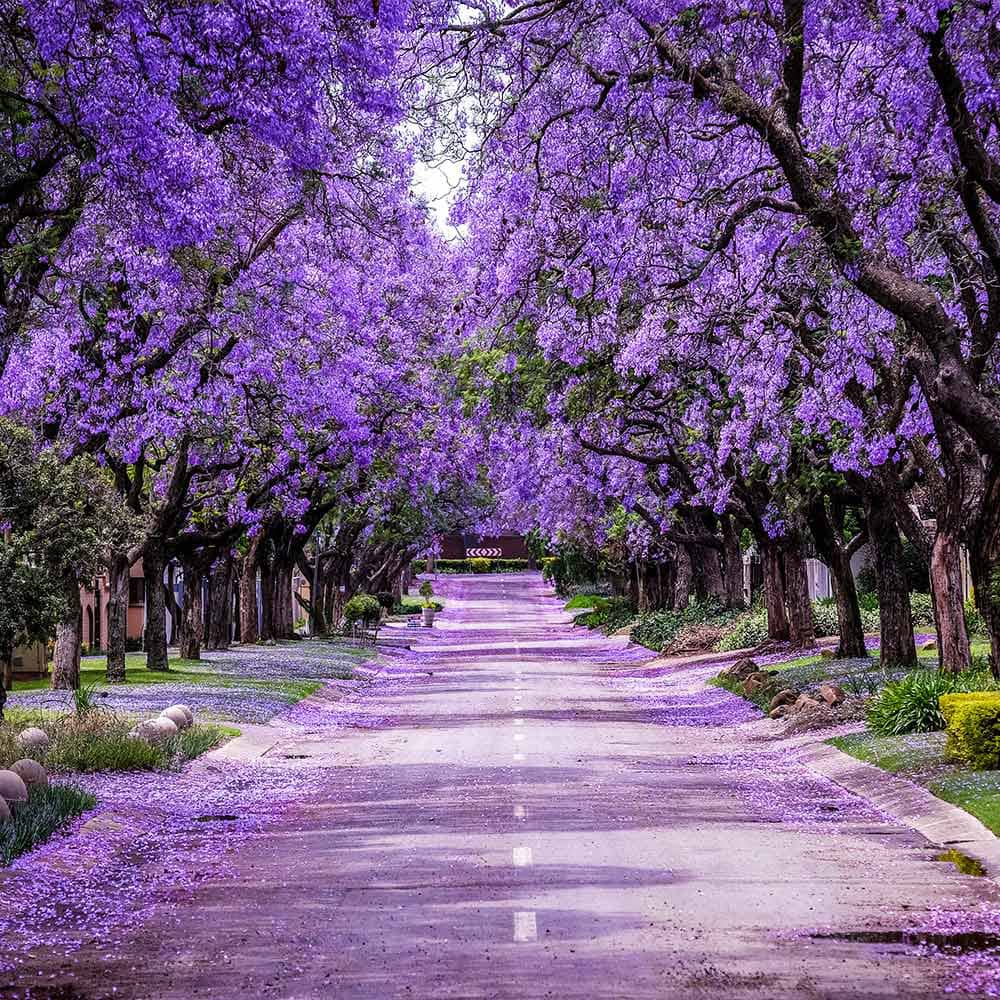The Purple Flower Tree Of Lustre
Share

MUTARE-One of those things that linger in our minds even if we happen to be
thousands of kilometres away from home, is the exquisite beauty of blooming
Jacaranda trees especially in September and October, when the temperatures
usually go North.
The purple-blue blossoms on the trees and on the ground, just make us wonder
how else natural beauty could be possibly presented or described.
Driving through or walking past interlocked branches that form a perfect
canopy of these species reportedly imported many years ago from South
America, one gets the feeling that indeed, there is no place better than home in
the summer time.
The temptation to pick a blossom and give it a gentle sniff, is irresistible.
Strength in beauty defines the unparalleled Jacaranda Tree. The powerful trunk
and thick branches that hoist all those lovely blooms and gilt leaves are strong
and resilient.
It is one tough tree that grows to a sturdy height and will thrive in a variety of
soil types.
Jacaranda trees are found all over Mutare and Zimbabwe’s other towns and
cities, as well as widely scattered across the countryside.
The urban populace always looks forward to the blossom which, apart from
simply being pretty, is seen as marking the change of seasons, the end of the dry
winter and the hope that summer rains will bring. Just as cherry blossom is a
Japanese icon, so too is jacaranda an icon of the streets of Mutare.
Jacarandas are actually not native to Zimbabwe. The name comes from Guaraní,
an Indigenous language spoken mainly in Paraguay and the tree has its origin in
the Amazon.
Jacaranda is in fact a native of South America, in particular of Brazil.
They are deciduous trees, meaning they lose their foliage every year when the
weather turns cold enough. And when temperatures rise, their bare, tortuous
branches fill with bunches of blooms.
Boom! Immediately, not progressively, the whole tree is full of flowers.
The flowers grow in bunches and bear an attractive purple-blue colour because
of anthocyanins, a pigment also found in dahlias, berries, black beans and sweet
potatoes.
The story of the Jacaranda Tree in Zimbabwe says that the plant was first
introduced to Fort Salisbury, now Zimbabwe’s capital, Harare in 1899 by a
honeymooning couple who carried home six seedlings from the botanical
gardens in Durban, South Africa.
As a result of the intensity of public works projects in the early 20th century,
Jacaranda Trees soon took root in Salisbury’s parks, gardens and alongside its
expanding road network.
The tree known to be an invasive species, soon took root across the country,
making it a signature tree along the busy streets of urban towns and cities.
According to the Zimbabwe Tourism Authority the Jacaranda season is one of
the most important moments in Zimbabwe as it draws domestic and
international tourists to the country.
Tourists from China, Japan, and South Korea, each year visit Zimbabwe during
the September and October months for the Jacaranda and constitute at least
three percent of total visitors received as tourists each year.
Statistics obtained from the Zimbabwe Tourism Authority (ZTA) indicated that
in 2019, the country realized $1.3 billion in tourism dollars which is 8 percent
of the country’s total revenue collected.
The streets of Mutare and Harare are usually busy around the Jacaranda season
as some visitors come to Zimbabwe just for photoshoots and marvel at the sea
of purple created by the foliage.
“The Jacaranda trees have for years been attracting tourists to the country where
they would have their wedding images taken. The lavender flowers from the
trees are popular with summer weddings and birthday shoots in the streets of
our major cities,” said a Mutare based wedding planner, Ronnie Gatsi.
Apart from capturing beautiful moments under the intertwined canopies of the
Jacaranda Trees lining the streets, the Jacaranda Festival also brings life and
lustre to the season.
“The Jacaranda Musical Festival aims to enhance Harare’s artistic and cultural
scene by bringing all people together to celebrate and be new, as symbolised by
the blooming Jacarandas that line the streets of Harare,” according to the
Jacaranda Music Festival website.
This year’s Jacaranda Music Festival running from October 6 to 8 will bring
South African choral group Ladysmith Black Mambazo. The group reigns
supreme as the most-decorated African acts in Grammy history. Performing
since 1960, the group has racked up 16 Grammy Award nominations, going on
to clinch the trophy a record-breaking five times.
The coming of the rains however, marks the end of the jacaranda’s brief reign.
It is soon replaced by flame trees whose flowering branches provide a scarlet-
red canopy across the city instead.
The Flame tree, also known as Royal Poinciana or Flamboyant, is found in
abundance in the towns of Mutare, Harare, Bulawayo and Masvingo.
It is also widely regarded as one of the most beautiful tropical trees in the world
They are called the Flamboyant trees because of their deep rich and stunning
red velvety blooms. The flowers are produced in spring and summer and the
leaves are shed in the dry season
These beautiful blooms signify the arrival of the summer season at the end of
October to mid-November which is also the beginning of the rainy season.
It is however not all pomp and fanfare when the Jacaranda Trees burst into
bloom as this also signifies one of the most stressful and at times traumatising
times for school goers across the country.
Besides the beauty of the Jacaranda bloom subsequently followed by the red
velvety bloom of the flamboyant tree, back in high school, the blooming of
the Jacaranda trees act as a reminder that ZIMSEC exams are around the corner
and it is time for examination classes to burn the midnight candle in study for
their public exams that would evidently define their futures in academics.







